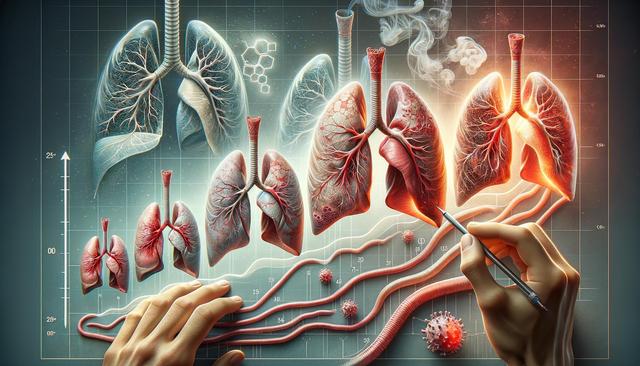What is COPD and How is it Staged?
Chronic Obstructive Pulmonary Disease, commonly referred to as COPD, is a progressive lung condition that makes it increasingly difficult to breathe over time. It encompasses two primary conditions: chronic bronchitis and emphysema. The disease is typically caused by long-term exposure to lung irritants, most often cigarette smoke, though environmental pollutants and genetic factors also play a role. The progression of COPD is categorized into four stages, which are based on the Global Initiative for Chronic Obstructive Lung Disease (GOLD) guidelines. These stages help healthcare providers determine the severity of the condition and guide appropriate management.
The staging of COPD is primarily determined using spirometry, a pulmonary function test that measures how much air a person can exhale and how quickly. The key metric used is the Forced Expiratory Volume in one second (FEV1). Based on the FEV1 percentage of the predicted value, patients are classified into one of four stages: mild, moderate, severe, and very severe. Understanding these stages is crucial for both patients and caregivers, as it sets the foundation for treatment plans and lifestyle adaptations.
Stage 1: Mild COPD
Stage 1 is often referred to as mild COPD. At this stage, the FEV1 is 80% or more of the predicted value. Symptoms may be subtle or even absent, which often leads to underdiagnosis. However, some individuals may notice a chronic cough or increased mucus production, especially in the mornings. Since the symptoms are minimal, individuals may not seek medical attention until the disease progresses.
Early diagnosis, even at this mild stage, can make a significant difference in managing the disease. Recommended actions may include:
- Smoking cessation, which is the single most important step in slowing disease progression
- Getting vaccinated against influenza and pneumococcal infections
- Beginning a light exercise routine to improve lung efficiency
Although lung function is only slightly reduced, damage to the lungs has begun, making it important to take preventive measures seriously.
Stage 2: Moderate COPD
In Stage 2, the FEV1 falls between 50% and 79% of the predicted value. Symptoms become more noticeable and may interfere with daily activities. Individuals often experience increased cough, more frequent respiratory infections, and shortness of breath, especially during physical exertion.
This stage marks the point at which many individuals first seek medical attention. Management strategies may include:
- Using bronchodilators to help open airways
- Joining a pulmonary rehabilitation program
- Establishing a personalized action plan for managing exacerbations
It’s essential at this stage to work closely with healthcare providers to monitor symptoms and adjust treatments as needed. Lifestyle adjustments, such as avoiding air pollutants and maintaining a balanced diet, also play a role in managing the condition effectively.
Stage 3: Severe COPD
Stage 3, or severe COPD, is characterized by an FEV1 between 30% and 49% of the predicted value. At this point, symptoms significantly impact quality of life. Individuals may experience persistent shortness of breath, fatigue, and frequent flare-ups that require medical intervention.
Daily tasks such as walking up stairs or carrying groceries become increasingly difficult. Management during this stage often includes:
- Long-acting bronchodilators and inhaled corticosteroids
- Supplemental oxygen therapy, if oxygen levels are low
- Continued participation in pulmonary rehabilitation
Frequent monitoring is crucial, as exacerbations can lead to hospitalizations and further decline in lung function. Emotional support and mental health care should also be considered, as the disease can cause anxiety and depression.
Stage 4: Very Severe COPD
Stage 4 is the most advanced stage, with FEV1 less than 30% of the predicted value or the presence of chronic respiratory failure. Symptoms are debilitating and may include extreme breathlessness, chronic fatigue, and a higher risk of life-threatening complications.
At this stage, the focus often shifts toward palliative care and improving quality of life. Treatment may involve:
- Continued oxygen therapy
- Use of non-invasive ventilation devices
- Advanced care planning and discussions about end-of-life care
Some individuals may be evaluated for surgical interventions such as lung volume reduction surgery or lung transplantation, though these are considered on a case-by-case basis. Comprehensive care often involves a team of specialists to address the complex needs of the patient.
Conclusion: Navigating Life with COPD
Understanding the stages of COPD is essential for effective disease management and long-term planning. Each stage presents unique challenges, but with timely diagnosis and appropriate interventions, individuals can maintain a higher quality of life. Whether at the early or advanced stage, proactive treatment and lifestyle modifications play a crucial role in slowing disease progression and managing symptoms. By staying informed and working closely with healthcare providers, those living with COPD can take steps to breathe easier and live more comfortably.












